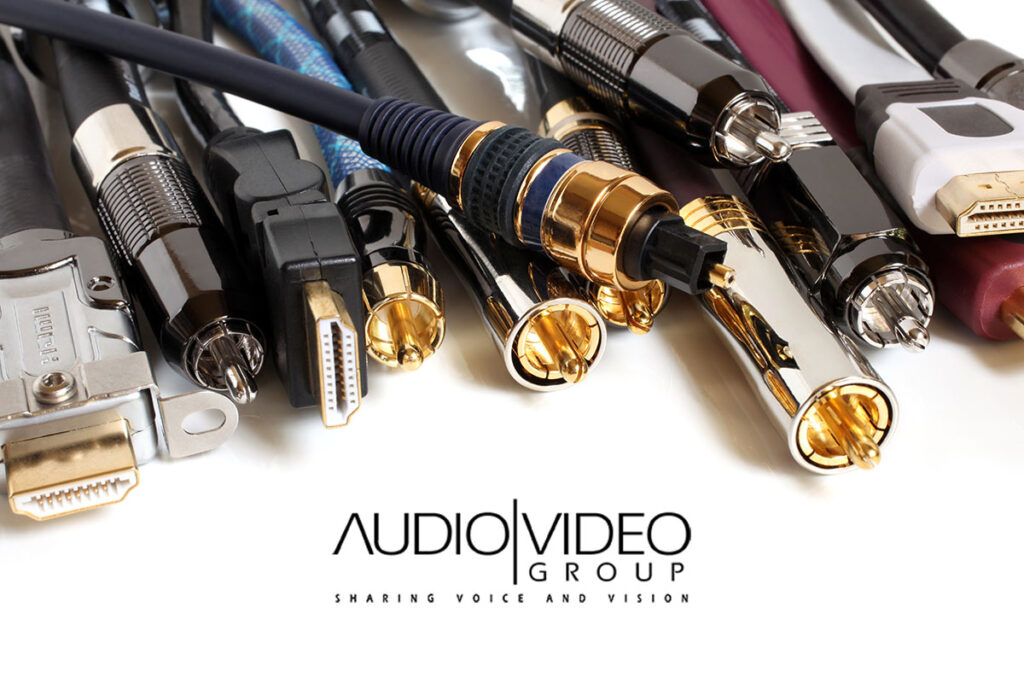Modern AV Cables and Connectors: An Overview

AV cables and connectors are the lifeblood of communications. They ensure that our meetings, presentations, events, and technological interactions remain seamless.
Let’s look at modern cables and connector types and see what they bring to the table.
HDMI (High-Definition Multimedia Interface)
Emerging in the early 2000s, HDMI streamlined the chaos of audio and video cables into a singular solution. Over time, it has become a global standard, and its versions have evolved to support even 8K video resolutions.
Retail spaces commonly employ HDMI for digital signage, given its ability to carry crisp HD and 4K video along with audio. Modern conference rooms frequently have HDMI ports to facilitate laptop-to-projector presentations.
Schools and colleges utilize HDMI for connecting devices to projectors and interactive boards.
HDMI Pros & Cons:
- Supports both audio and video in high definition and even 4K.
- Can also support 3D and Ethernet data.
- May require converters for older equipment and has length limitations.
DisplayPort
While HDMI catered to the broad market, DisplayPort emerged to address the high demands of tech professionals. It pushed boundaries, offering features like multi-stream transport (daisy-chaining multiple monitors to a single port) and adaptive sync.
When digital signage calls for ultra-high-definition displays or interactive touchpoints, DisplayPort is usually the connector of choice.
Graphic design studios, where precise color and sharpness are paramount, often rely on DisplayPort for their high-end monitors.
Medical facilities, especially those running sophisticated imaging devices, harness the potential of DisplayPort for clear, detailed visuals.
DisplayPort Pros & Cons:
- Offers resolutions surpassing HDMI.
- Supports multiple video streams.
- Not as prevalent as HDMI, and the physical connector might feel less secure.
VGA (Video Graphics Array)
VGA is a testament to technology that lasts. Designed in the late 1980s, VGA was the standard for computer displays for years. Despite being analog, and thus having some limitations in a digital world, its widespread adoption means it’s still seen in many places.
Educational institutions on tight budgets, or those with older infrastructure, still have VGA connectors running classroom projectors.
Some businesses with older tech setups or those who opt for backward compatibility also find VGA connectors in their conference or huddle rooms.
VGA Pros & Cons:
- Offers backward compatibility with vintage devices.
- Limited to video signals and suffers from quality loss due to its analog nature.
DVI (Digital Visual Interface)
Positioned as a successor to VGA, DVI emerged to bridge the analog and digital worlds. It was versatile and compatible with old-school VGA devices and newer digital ones.
Many corporate offices during the analog-to-digital transition phase incorporated DVI connectors. They can link desktops to monitors or facilitate AV setups in institutions like churches, which might be blending old and new tech.
DVI Pros & Cons:
- Capable of transmitting both analog and digital signals.
- Does not support audio and has a bulkier connector.
XLR
XLR has been around since the 1950s, and its three pins have become synonymous with professional audio setups. Designed for longevity and robust performance, XLR cables offer balanced audio, minimizing interference.
XLR’s strength lies in audio clarity. Hence, it’s the first choice for PA systems in a school auditorium or large public events. Churches rely on XLR for sermons and musical performances.
Hospitals also often use systems with XLR connectors to ensure clear paging or announcements.
XLR Pros & Cons:
- Offers balanced audio transmission, reducing interference.
- Bulkier than other audio connectors.
3.5mm and 1/4″ Jacks
From personal headphones to professional audio setups, these jacks have maintained their relevance over the years. Their simplicity and versatility have made them almost universal for audio connections.
Educational institutions use them for microphones in auditoriums. Offices deploy them for headsets, especially in environments like call centers.
PA systems might have inputs for mics or instruments using these jacks.
3.5mm and 1/4″ Pros & Cons:
- Universally recognized and compact.
- Can be susceptible to interference in unbalanced configurations.
USB Type-C
USB Type-C, often referred to as USB-C, is a recent advancement in the USB family. Its reversible design and ability to deliver data, video, audio, and power—all through a single, slim connector — made it a game-changer on the market.
USB-C has become increasingly prominent in modern office spaces, especially with the rise of laptops and devices that use it as their primary port. It is often the connector of choice for docking stations and hubs that connect a laptop to multiple peripherals, including monitors, projectors, and sound systems.
Furthermore, many digital signage solutions are starting to incorporate USB-C due to its flexibility in carrying both power and data. Its power delivery capability also means fewer cables are needed, leading to neater setups, especially in conference rooms and collaborative workspaces.
USB-C Pros & Cons:
- Transmits power, data, audio, and video through a single cable, simplifying setups and reducing clutter.
- Widely adopted in modern devices.
- Can be pricier than traditional cables.
As you can see, each connector, from the legacy VGA to the modern USB-C, brings its own strengths and challenges. As technology evolves, staying updated and adaptable ensures that your AV game remains strong, facilitating impactful communication and collaboration in the professional space.
If you need help choosing the right interface types for your next AV setup – we’re here to help. Contact us, and let’s talk!

